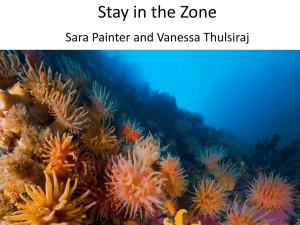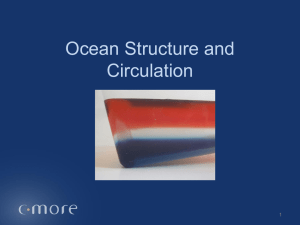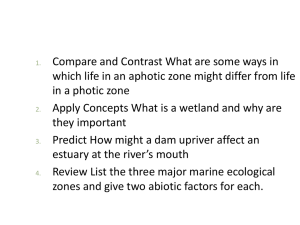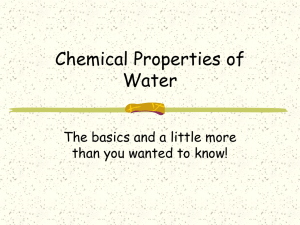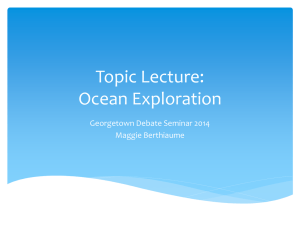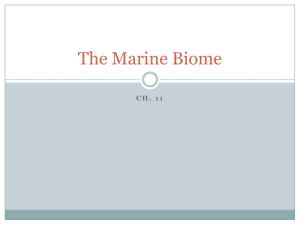Ocean Life & Productivity: Marine Biology Presentation
advertisement
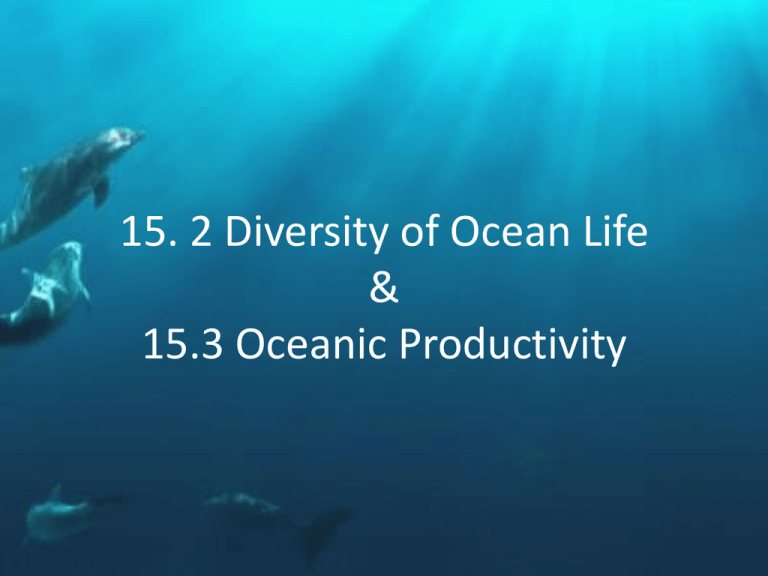
15. 2 Diversity of Ocean Life & 15.3 Oceanic Productivity Classification of Marine Organisms • Classified based on where they live & how they move – Plankton: floaters – Nekton: swimmers – Benthos: bottom dwellers Plankton • Include all organisms – algae, animals, & bacteria • Move with the ocean currents • Can swim • Algae that undergoes photosynthesis = phytoplankton • Microscopic • Animal plankton = zooplankton Nekton • Include all animals capable of moving independently of the ocean currents by swimming • Can migrate long distance • Include most adult fish, squid, marine mammals, & marine reptiles Benthos • Describes organisms living on or in the ocean bottom • Shallow coastal ocean floor contains a wide variety of physical conditions & nutrient levels • Deeper parts = photosynthesis can not occur – They feed on each other and whatever falls from above Marine Life Zones • 3 factors used to divide the ocean into life zones: – Availability of sunlight – Distance from shore – Water depth Availability of Sunlight • Photic zone = sunlight • Euphotic zone = portion of the photic zone near the surface where photosynthesis can occur (up to 100 m deep) • Aphotic zone = no sunlight Distance from Shore • Subdivided based on distance • Intertidal Zone = land & ocean meet & overlap – Harsh living conditions due to crashing waves, drying out time to time, quick temperature changes, salinity, & oxygen concentrations – Adapted • Neritic Zone = covers gently sloping continental shelf • Narrow – hundreds of km from shore • Shallow enough for sunlight to reach ocean floor = photic zone • 90 % of the worlds commercial fisheries because it is so rich • Oceanic Zone = beyond continental shelf • Surface waters have lower nutrient concentrations because nutrients sink out of the photic zone to the deep ocean floor – Smaller populations than the more productive neritic zone Water Depth • Pelagic Zone = open ocean of any depth • Animals = swim or float freely – Photic area of the pelagic zone home to: phytoplankton, zooplankton, nekton – Aphotic area fo the pelagic zone home to: giant squid & other species that have adapted to deep waters • Benthic Zone = any sea – bottom surface (regardless of the distance from shore) • Mostly inhabited by benthos organisms • • • • • Abyssal Zone = subdivision of the benthic zone Extreme pressure Low temperatures No sunlight Little life forms Hydrothermal Vents • Along the oceanic ridges • Seawater seeps into the ocean floor through cracks in the crust • Becomes heated and saturated with minerals • Minerals precipitate out when it comes in contact with cold ocean water (black smoke color) 15.3 OCEANIC PRODUCTIVITY Primary Productivity • Production of organic compounds from inorganic substances through photosynthesis or chemosynthesis • Photosynthesis – use of light energy to convert water and CO2 into glucose molecules • Chemosynthesis – process by which certain microorganisms create organic molecules from inorganic nutrients using chemical energy • 2 factors influence a area’s photosynthetic productivity: – Available nutrients – Amount of solar radiation Productivity in Polar Oceans • Density & temperature change very little with depth in polar regions • Summer = melting ice = lower salinity • Availability of solar energy is what limits photosynthesis productivity in polar areas Productivity in Tropical Oceans • Productivity is low & limited bc of lack of nutrients • The sun is more directly overhead > light penetrates deeper into the tropical ocean than in temperate and polar waters • Solar energy is available year around • Permanent therocline prevents mixing btw surface waters and nutrient rich deeper waters Productivity in Temperate Oceans • • • • • Found at mid-latitudes Winter Spring Summer Combination of these 2 limiting factors to control productivity – Sunlight – Nutrient supply Oceanic Feeding Relationships • Tropic Levels – Feeding levels – Zooplankton = herbivores (eat algae) – Herbivores eaten by Carnivores • Transfer efficiency – The transfer of energy btw tropic levels is inefficient • Food Chain / Food Web – Sequence of organisms where energy is transferred starting with a primary producer – Feeding relationships = Food Web Review Questions • What factors influence a region’s photosynthetic productivity? • Compare/Contrast Food Web & Food Chain • Compare/Contrast Photosynthesis & Chemosynthesis • How are marine organisms classified? • Why is the neritic zone rich in life?
